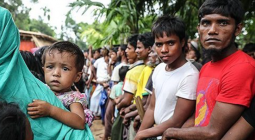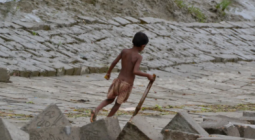‘Every year it gets worse’: on the frontline of the climate crisis in Bangladesh
Ever since she was a little girl, Amina Ahmed has been afraid of the water. Growing up in Sylhet, north-east of Bangladesh, the heavy rainfall that typically occurs during monsoon season would make her anxious.
But this year’s flooding has been unlike anything she’s ever seen before. “Every year, it gets a little worse but I don’t think anyone expected anything this extreme,” Ahmed says.
Over the past few weeks, catastrophic flash floods – the worst in Bangladesh in a century – have inundated much of Sylhet, where rising waters have washed away whole towns, killing at least 68 people and leaving thousands displaced. According to the UN, an estimated 7.2 million people across seven districts have been affected.
Now 24, Ahmed, from Mirabazar, is a volunteer for the Bangladesh Red Crescent, where she is part of a team leading rescue and relief operations during the current crisis.
When the recent flooding began, Ahmed’s team tried to reach people in remote areas and bring them safely to shelter. They carried small children for those struggling to stay afloat and provided regular reassurance to terrified families, as well as cooked meals, clean drinking water and medicine.
Ahmed recognises that women in Sylhet are more likely to be affected by the climate emergency than men, which is a key motivation for her work. “I’m in the best position to help impacted women as I personally understand the gender-based issues that they face,” she says.
One such problem is a lack of adequate toilet facilities in shelters for menstruating women and girls. “There are no proper washrooms so when they get their periods, they don’t have access to disposal bins or space to change,” says Ahmed. She describes the cramped conditions of the shelters, with multiple families living under the same roof and only one shared bathroom. The provision of sanitary towels in emergency packages is often overlooked, so Ahmed is making sure they are included.
Since many of the makeshift shelters are accessible only by boat, Ahmed has been forced to confront her fear of water. She travelled for hours in a rickety boat to deliver emergency aid to more than 200 families. “The boat was overloaded and at one point, the water started to come in,” recalls Ahmed, who cannot swim. “I thought we might drown but, luckily, we were able to move on to another boat and continue our mission.”
Humayara Jeba, 20, a climate fighter at YouthNet, the largest youth-led network for climate advocacy in Bangladesh, says women and girls are the most affected by the flooding because of their limited access to resources. “With high existing levels of poverty and inequality, climate change is intensifying the everyday challenges they already face,” she says.
For the past year and a half, Jeba, from Shahi Eidgah, has been involved in crisis response planning – so when the recent floods struck, she was ready. She was pivotal in making sure those most at risk made it to safety, including children, elderly people and pregnant women.
One of these was Rita Akhter, 19, who is eight months pregnant with her first child. Akhter was resting when the water levels outside her tin hut started to drastically rise. She was awoken by shouts from neighbours and climbed out of bed to find herself waist deep in water. “My body was in so much pain that I could barely move,” she says. “I was terrified for my unborn child and didn’t think that we would make it.” Within 10 minutes, the water had reached her neck.
Jeba helped to escort Akhter out. When they looked back, the hut was submerged, along with all Akhter’s possessions. “In the blink of an eye, everything was lost,” Akhter says.
All the emergency shelters nearby were full, so Jeba offered shelter in her own home. “It was the least I could do,” she says. “But I worry what will happen if she goes into labour. Hospitals are currently inaccessible due to flooding.”
An estimated 60,000 women are pregnant in the affected region, with more than 6,500 births expected to take place in July. According to Sylhet health department, 24 healthcare facilities have sustained extensive damage, including MAG Osmani Medical College hospital, the city’s main hospital, which usually treats up to 5,000 patients a day.
Of the 926 community clinics scattered throughout Sylhet, 414 are under water. Dr Himanshu Roy, Sylhet’s divisional health director, says that an outbreak of waterborne diseases has left medical staff struggling to cope.
Across town, Nawfat Ibshar, 18, from Habiganj, has been busy planning her next climate protest. Frustrated by the lack of global response, Ibshar wants to ensure that the plight of her people is heard. “Organising people to come together during a crisis is of course difficult,” she says. “But people are angry. If we don’t demand change, who will?” She holds up a banner she has spent the afternoon making, which reads: “We’ll be dead by Cop27 #ActNow” in bright orange handwriting.
On the day of the protest, a group led by Ibshar march down a busy road, chanting climate crisis slogans in Bangla and English. One protester holds up a sign that reads, “Up to my neck in the climate crisis” – while half submerged in flood water.
“We don’t expect much from global leaders as we’ve become used to their empty promises,” says Ibshar. “But we can always expect Sylhetis to show up, especially during a crisis.”




